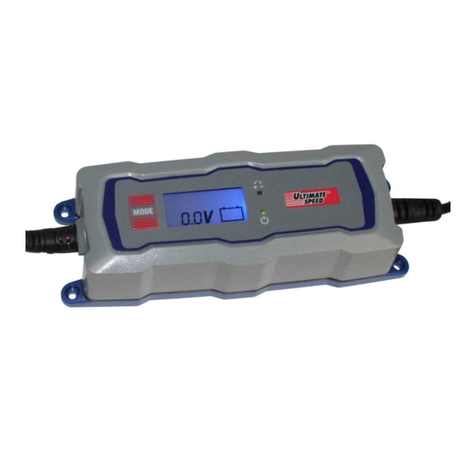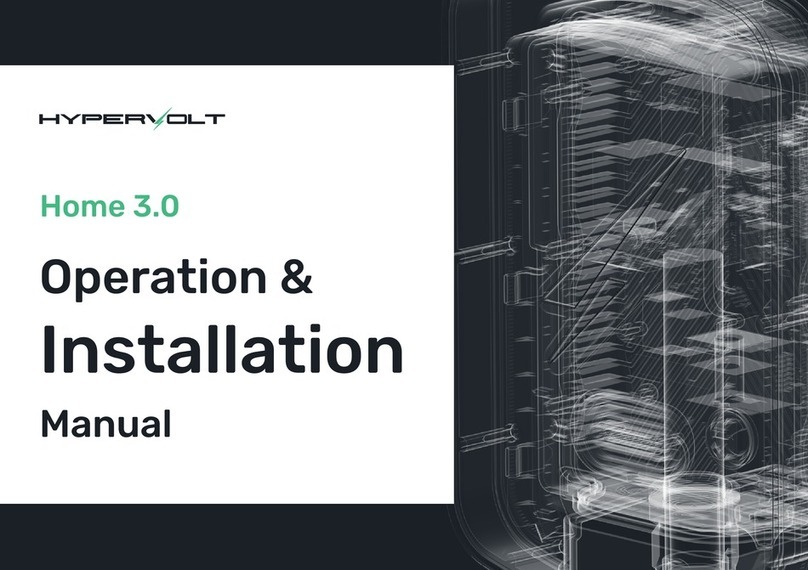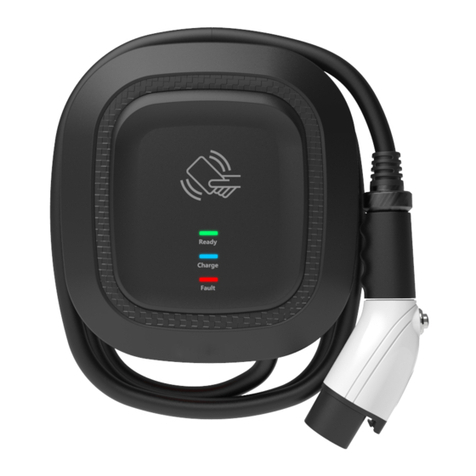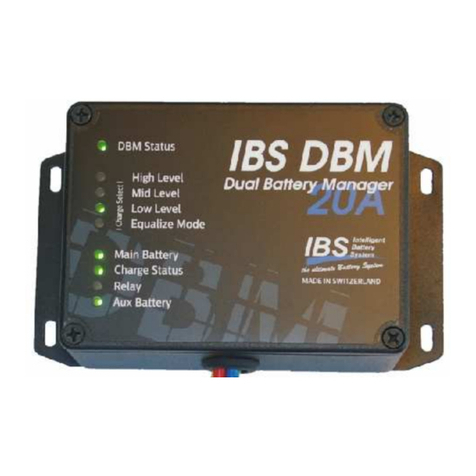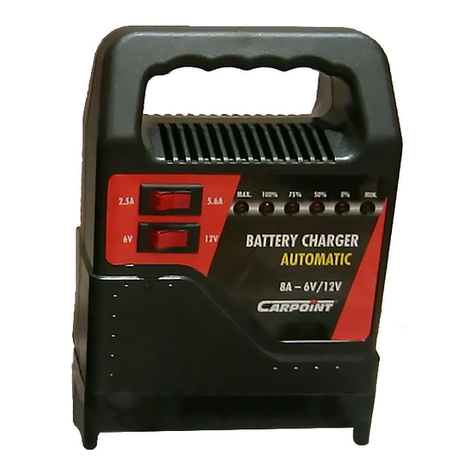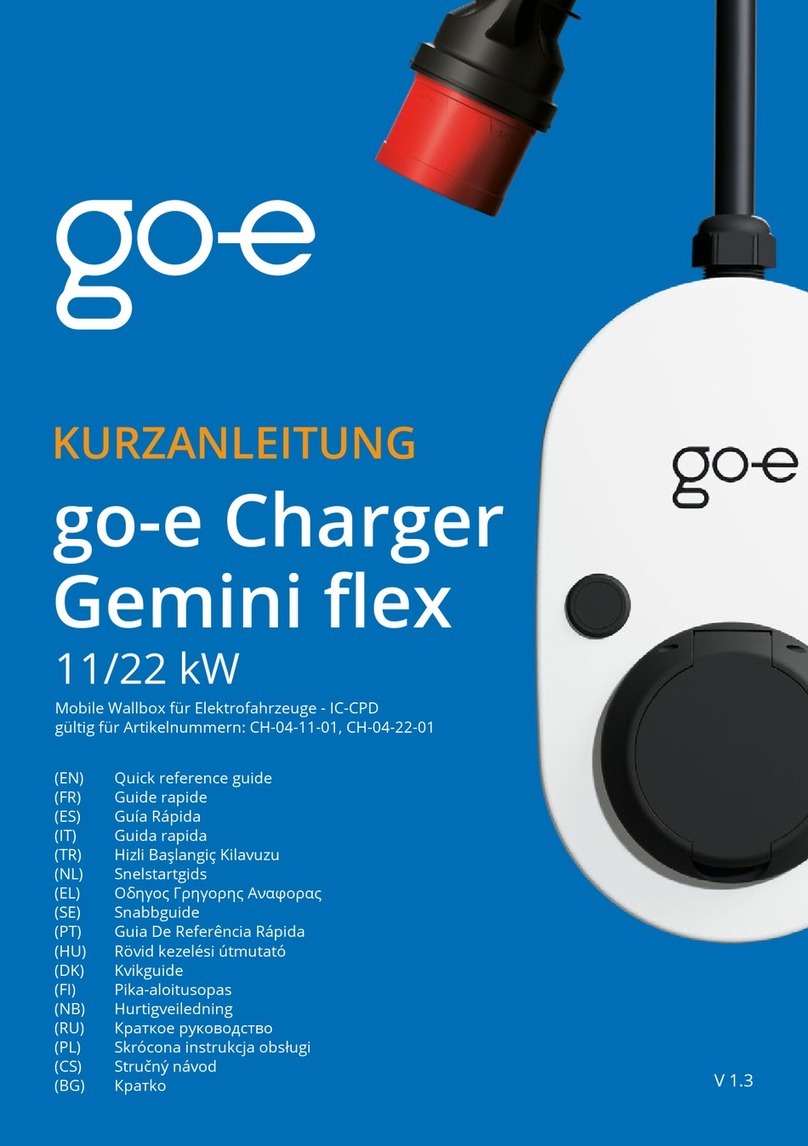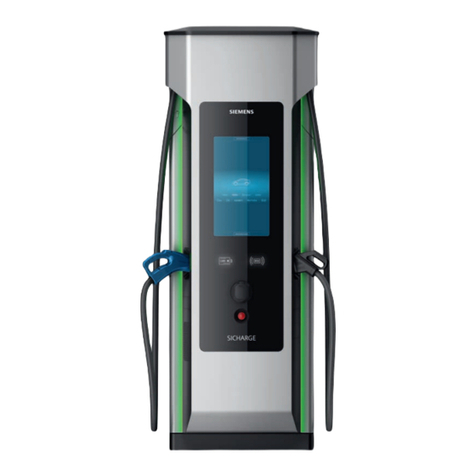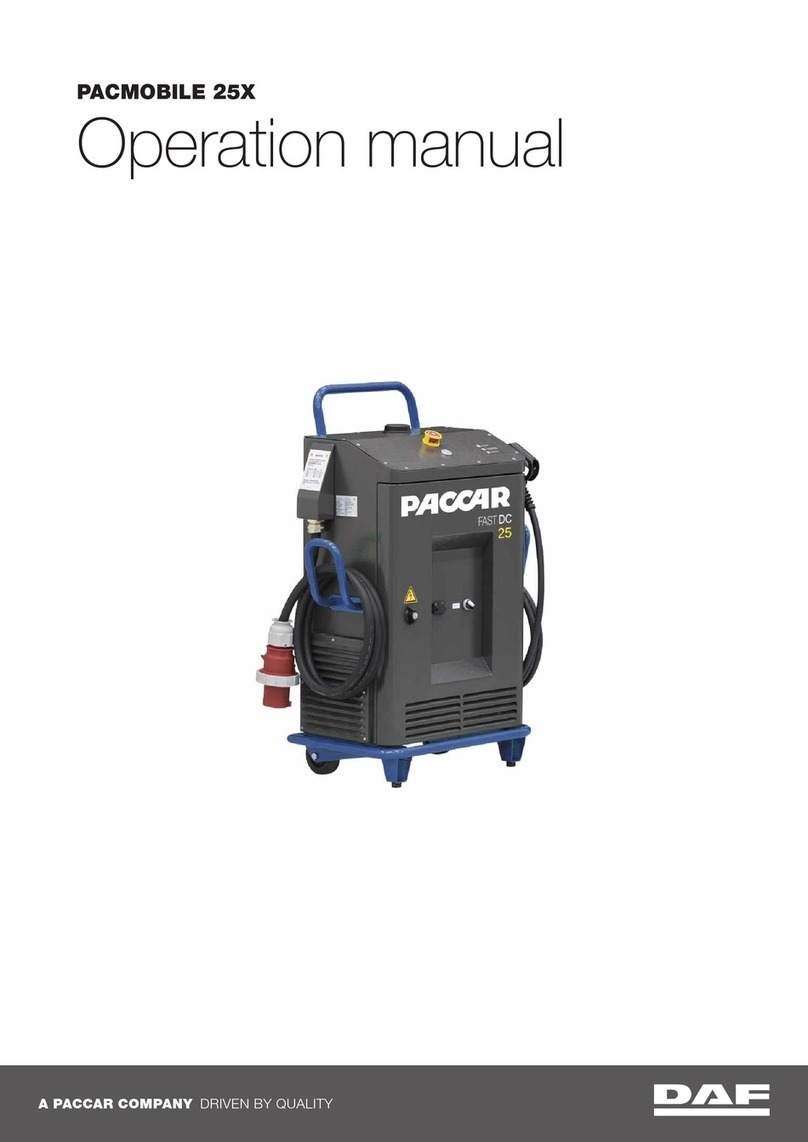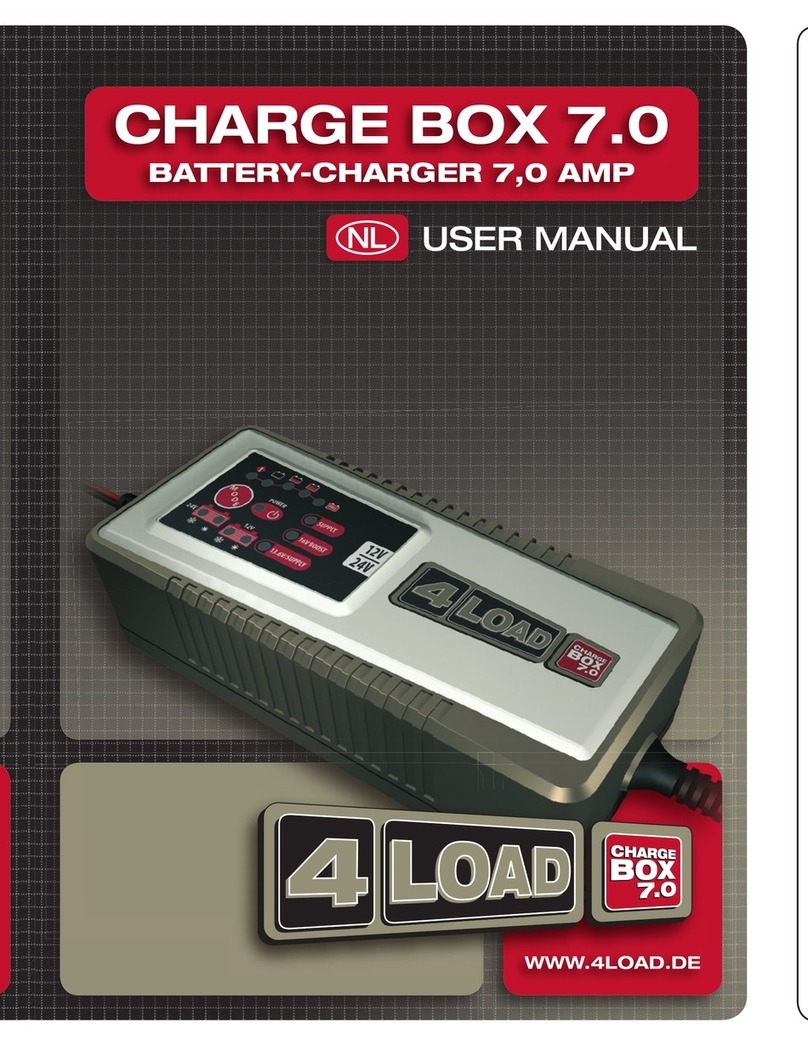TRUCK PAC ES1224 User manual

ES1224
User’s Manual
Failure to follow instructions may
cause damage or explosion,
always shield eyes. Read entire
instruction manual before use.
WARNING
Warning: This product contains chemicals,
including lead, known to the State of
California to cause cancer, birth defects
and other reproductive harm.
Wash hands after handling.
WARNING
Never hook up a 12 Volt DC power source to a 24 Volt DC vehicle. This will grossly
overcharge the 12 Volt power source and generate flammable gasses that may explode
and cause property damage and/or bodily harm.

Congratulations! You have just purchased the finest quality portable power source and
jump starter on the market. We have taken numerous measures in quality control and
in our manufacturing processes to ensure that your product arrives in top condition,
and that it will perform to your satisfaction.
In the rare event that your Truck PAC contains a damaged or missing item, does not
perform as specified, or requires warranty service, please call Technical Service at
(913) 310-1050. Save your purchase receipt, it is required for warranty service.
This unit has a sealed lead-acid battery that should be kept at full charge. Recharge
when first received, immediately after each use, and every three months if not used.
Failure to perform maintenance charges may cause the battery life to be reduced
greatly.
SAFETY SUMMARY
WARNING
Read these instructions completely before using the Truck PAC and save them for future
reference. Before using the Truck PAC to jump start a car, truck, boat or to power any
equipment, read these instructions and the instruction manual/safety information
provided by the car, truck, boat or equipment manufacturer. Following all manufacturers’
instructions and safety procedures will reduce the risk of accident.
Working around lead-acid batteries may be dangerous. Lead-acid batteries release
explosive gases during normal operation, charging and jump starting. Carefully read and
follow these instructions for safe use. Always follow the specific instructions in this
manual and on the Truck PAC each time you jump start using the Truck PAC.
All lead-acid batteries (car, truck and boat) produce hydrogen gas which may violently
explode in the presence of fire or sparks. Do not smoke, use matches or a cigarette
lighter while near batteries. Do not handle the battery while wearing vinyl clothing
because static electricity sparks are generated when vinyl clothing is rubbed. Review all
cautionary material on the Truck PAC and in the engine compartment.
Always wear eye protection, appropriate protective clothing and other safety equipment
when working near lead-acid batteries. Do not touch eyes while working on or around
lead-acid batteries.
Always store clamps in their holsters, away from each other or common conductors.
Improper storage of clamps may cause the clamps to come in contact with each other,
or a common conductor, causing the battery to short circuit and generate high enough
heat to ignite most materials.
Use extreme care while working within the engine compartment, because moving parts
may cause severe injury. Read and follow all safety instructions published in the vehicle's
Owner's Manual.
While the battery in the Truck PAC is a sealed unit with no free liquid acid, batteries
being jump started with the Truck PAC unit likely contain liquid acids which are
hazardous if spilled.
WARNING
Never hook up a 12 Volt DC power source to a 24 Volt DC vehicle. This will grossly
overcharge the 12 Volt power source and generate flammable gasses that may explode
and cause property damage and/or bodily harm.

3
PERSONAL PRECAUTIONS
Someone should always be within range of your voice or close enough to come to
your aid when you work near a lead-acid battery.
Have plenty of fresh water and soap nearby in case battery acid contacts skin,
clothing or eyes. Protective eyewear should always be worn when working near
lead-acid batteries.
If battery acid contacts skin or clothing, wash immediately with soap and water. If acid
enters eye, immediately flood eye with running cold water for at least 10 minutes and
get medical attention immediately.
Be extra cautious to reduce risk of dropping a metal tool onto a battery. It might spark
or short circuit the battery or another electrical part that may cause explosion.
Remove personal metal items such as rings, bracelets, necklaces and watches when
working with a lead-acid battery. A lead-acid battery can produce a short-circuit
current high enough to weld a ring or the like to metal, causing a severe burn.
Use the Truck PAC for jump starting lead-acid batteries only. Do not use for jump
starting dry-cell batteries that are commonly used with home appliances. These
batteries may burst and cause injury to persons and damage to property.
NEVER charge or jump start a frozen battery.
To prevent arcing, NEVER allow clamps to touch together or to contact the same
piece of metal.
IMPORTANT SAFETY INSTRUCTIONS
Use of an attachment not recommended or sold by the manufacturer may result in a
risk of damage to the unit or injury to personnel. In addition, modifying or changing the
Truck PAC can be dangerous and will void the warranty on this product.
When using the wall charger or power extension cord, pull on the plug and never on
the wire when disconnecting.
Do not recharge the Truck PAC with a damaged wall charger or power extension cord.
Replace them immediately.
The Truck PAC may be used under any weather condition – rain, snow, hot or cold
temperatures.
Do not submerge in water.
Do not operate with flammables such as gasoline, etc.
If the Truck PAC receives a sharp blow or is otherwise damaged in any way, have it
checked by a qualified service person. If the Truck PAC is leaking battery acid, do not
ship it. Take it to the closest battery recycler in your area.
Do not disassemble the Truck PAC. Have it checked by a qualified service person.
The Truck PAC should never be left in a completely discharged state for any period of
time. Damage to the battery could be permanent, with poor performance as a result.
When not in use, leave your Truck PAC connected to the wall charger or recharge
every three (3) months.

4
OPERATION AND MAINTENANCE
Portable Power Source Features
The Truck PAC provides plenty of power for starting vehicles – more than enough to
start most cars, vans, SUVs, light trucks and delivery vehicles.
The Truck PAC will power most 12VDC accessories equipped with a male 12 Volt
outlet plug. The DC outlet features automatic overload protection.
The unit features a test switch and LED lights. State of the art circuitry allows the unit
to remain continuously connected to the charger without the risk of overcharging.
Safety Features
The Truck PAC ES1224 features our exclusive AWS - Advanced Warning SystemTM
enhancement to alert the operator to unsafe jump starting conditions. For more
information regarding AWS, please see the Operating Instructions section of this
manual.
Safety storage holsters prevent accidental sparking of clamps and rotate 90° for easy
clamp removal and replacement. Always re-wrap cables and properly secure clamps
in holsters after each use.
The Truck PAC contains the latest technology with its 12 Volt sealed, non-spillable
battery and may be stored in any position.
Recharging Procedures
Note: Upon initial purchase, your Truck PAC should be charged for a minimum of 24
hours.
Figure 2. Test Button, Charging, Power Levels and Charge Complete LEDs
There are two ways to charge your Truck PAC. The recommended method is
automatic charging using the supplied wall charger. An alternative method is through
the DC power outlet using the provided 12 Volt Male-Male Extension Cord. This
second method is not automatic and must be monitored because the Truck PAC could
be damaged due to overcharging, plus the Voltage Selector Switch must be in the 12V
position when using this charging method.

5
Charging using the supplied wall charger (recommended method). This is the
recommended charging method because it features automatic charging, eliminating
the possibility of overcharging. With this method, the wall charger is connected to the
Truck PAC through a small charging jack (pin jack), located on the rear of the unit.
Recharging takes approximately 4 to 6 hours for each light that does not come on
when the Test Button is pressed. With this method, your Truck PAC can be left
connected to the wall charger indefinitely.
1. Insert the wall charger pin into the CHARGING JACK (located in the front of the
Truck PAC).
2. Connect the wall charger AC/DC ADAPTOR to the AC outlet (the yellow
CHARGING light will light). (See Figure 2.)
3. Allow the Truck PAC to charge until the CHARGE COMPLETE light comes on
(you can monitor the progress by checking the red POWER LEVEL lights – after
all three POWER LEVEL lights are lit the CHARGE COMPLETE light should
come on).
4. Once the CHARGE COMPLETE light comes on, charge another three to six
hours (three hours is acceptable, but to ensure maximum output capability, six
hours is preferred).
Note: The CHARGE COMPLETE LED indicates that the charging process is
complete. It may illuminate for a short period after the charger is unplugged
from the unit due to the surface charge, but this will only occur for a short time,
which is normal. To assess the unit’s readiness, monitor the Power Level LED’s.
5. If you are not planning to use your Truck PAC right away, you may leave it
connected to the wall charger. We recommend that the wall charger remain
connected to the Truck PAC when not in use.
Charging using the supplied 12 Volt Male-Male Extension Cord. This alternative
charging method may be used when access to an AC outlet is unavailable.
1. Start the vehicle’s engine.
2. Plug one end of the 12 Volt Male-Male Extension Cord into the Truck PAC
12 Volt outlet and the other end into a vehicle 12 Volt outlet. Set the Voltage
Selector Switch to 12V mode.
3. Press the Test Button once every hour to check the POWER LEVEL. When all
of the red lights come on, charge the Truck PAC another 1 to 2 hours to ensure
a complete recharge.
Note: DO NOT OVERCHARGE! This is not an automatic method of charging
the Truck PAC. You must frequently monitor the charging process to ensure the
unit is not overcharged.
WARNING: Overcharging the Truck PAC when using this charging
method can create explosive gasses which could result in property
damage and personal injury. DO NOT OVERCHARGE!

6
OPERATING INSTRUCTIONS
Safety Check List
Always Perform this Step Before Use to Ensure Safe Operation
1. Check that the 2 vent plugs in the rear case are in good condition, are fully
seated and the white GORE-TEX®material has not previously been dislodged.
WARNING: if the plugs are out of position or the white material is missing
or loose, this means that the venting system has been activated and the
batteries are damaged. IMMEDIATELY take the unit out of service, and
send it to Clore Automotive for repair. See Warranty Section for details.
2. Check to make sure that the Voltage Selector Switch is in the OFF position.
3. Check to make sure that the clamps and cables are in good working order.
Signs that the clamps may be damaged include, but are not limited to the
following:
- Burn Marks on the Jaws
- Damaged clamp handles
- Damaged clamp springs
- Damaged cables where copper wiring may be exposed (insulation jacket
deteriorated, cut or missing)
4. Check to make sure the case is not swollen (a sign of damaged batteries).
5. Check to make sure the holsters (where the clamps should be stored) are in
good condition. These are designed to ensure that the clamps cannot come in
contact with each other, or come in contact with a common conductor.
Verifying these 5 simple check points before every use will keep your Truck PAC safe
to use and increase its service life.
Used as an Emergency Jump Starter
Note: For optimum performance, do not store your Truck PAC below 50° when using
as a jump starter. Never charge or jump start a frozen battery.
Advanced Warning System (AWS)TM – HAZARD WARNING FEATURE
Your Truck PAC is equipped with our AWS – Advanced Warning System – designed to
provide an advanced alert to common jump starting mistakes. Your Truck PAC
contains a buzzer which will sound an audible alarm if the Advanced Warning System
detects specific undesirable conditions during the jump starting process.
If the AWS Detection Alarm sounds at any time during the jump starting process,
disconnect the Truck PAC from the vehicle immediately! Always remember to practice
jump starting safety and disconnect the ground clamp first.
WARNING
Never hook up a 12 Volt DC power source to a 24 Volt DC vehicle. This will grossly
overcharge the 12 Volt power source and generate flammable gasses that may explode
and cause property damage and/or bodily harm.

7
Jump Starting Instructions
See details on next page for conditions that activate the AWS Detection Alarm.
1. Use in a well ventilated area.
2. Shield eyes. Always wear protective eyewear when working near batteries.
3. Prior to jump starting, review this entire instruction manual and the
instruction/safety manual provided by the manufacturer of the vehicle being
jump started.
4. Turn vehicle ignition OFF before connecting jump starter to vehicle.
5. Confirm vehicle voltage.
6. Ensure that the Truck PAC’s Voltage Selector Switch is in the OFF position prior
to connecting to the vehicle. Connect to vehicle.
7. With the Truck PAC’s Selector Switch in the OFF position, clamp the positive
(red +) clamp to the positive terminal on the vehicle battery (for negative ground
system), or an alternate vehicle starting point as recommended by vehicle
manufacturer.
8. Clamp the negative (black -) clamp to vehicle frame (ground).
9. Choose Truck PAC Voltage, by turning the Selector Switch to the desired mode,
to match vehicle voltage.
WARNING: Failure to properly match Truck PAC voltage and vehicle
voltage may result in explosion, product damage and bodily harm.
If AWS audible alarm sounds upon selecting Truck PAC Voltage, DISCONNECT
FROM VEHICLE IMMEDIATELY (remove negative clamp from vehicle ground).
10. Make sure the cables are not in the path of moving engine parts
(belts, fans, etc.)
11. Stay clear of batteries while jump starting.
12. Start the vehicle (turn on the vehicle ignition).
Note: If the vehicle doesn’t start within 6 seconds, let the Truck PAC cool for
3 minutes before attempting to start the vehicle again or you may damage
the Truck PAC.
13. When the vehicle is started, disconnect from vehicle, first disconnecting the
negative (–) battery clamp from the vehicle frame and return it to its holster, then
disconnecting the positive (+) clamp and return it to it’s holster. Then, turn
Voltage Selector Switch to the OFF position.

8
Advanced Warning System (AWS) – Causes for Detection Alarm Activation
1. Improper connection causing a reverse polarity condition. If your Truck PAC
is connected improperly, such that a reverse polarity condition exists, the
AWS Detection Buzzer will sound immediately upon completing the connection
to the vehicle.
2. Improper Truck PAC Voltage Selection when connected to a 24 Volt Vehicle. If
your Truck PAC is connected to a 24 Volt vehicle and you turn the Truck PAC
Voltage Selector Switch to 12 Volt mode, the AWS Detection Buzzer will sound.
3. Connecting to a completely drained battery while there is still a load on the
vehicle’s electrical system. If this condition occurs, remove the load that is on
the vehicle’s electrical system (headlights, dome light, radio, etc.) and set the
Truck PAC’s Voltage Selector Switch to match vehicle’s voltage.
Used as an Alternative Power Supply for Vehicles - In 12V Mode Only
Your Truck PAC is an essential tool for all who replace automobile batteries.
Most vehicles have electronic components with memory, such as alarm systems,
computers, radios, phones, etc. and when the vehicle’s battery is replaced, the
memory is lost. However, if the Male-Male extension cord is plugged from the Truck
PAC to the 12 Volt outlet on the vehicle, the memories can be saved.
Note: To use the Truck PAC for this purpose, the chosen outlet must be live when the
vehicle is turned OFF. On some vehicles, 12 Volt outlets are deactivated when the
vehicle is turned OFF.
Used as a Multipurpose Power Supply
Your Truck PAC is also a portable power source for all 12VDC accessories equipped
with a male 12 Volt plug. The DC outlet on the Truck PAC has automatic overload
protection.
When your Truck PAC is used with a DC to AC power inverter, it can operate
appliances normally powered by 120 Vac or 220 Vac. Recommended inverter for the
portable power source is 300 watts maximum. For more information, contact your
nearest Truck PAC dealer.

9
TROUBLESHOOTING
Problem: 1 or 2 red lights come on, charger is plugged in for 24 hours and there is
no change in status of lights.
Answer: Check charger to see if it is charging. Charger should be warm.
Problem: Charger works well but still no change in status of lights when the wall
charger is connected to the Truck PAC (yellow light is on).
Answer: Possible defective battery or faulty breaker. Try using a device (light, TV,
etc.) with a 12V plug on it to see if it works. If it operates, the Truck PAC
breaker is OK and the battery is the problem.
Problem: All of the lights come on when the charger is plugged into the Truck PAC,
but when the charger is unplugged and the test button pressed, no lights
come on.
Answer: Your Truck PAC has a defective battery which must be replaced.
Problem: The Truck PAC is fully charged but has no power.
Answer: Check where the wire meets the jaw on the Truck PAC clamp. Make sure
they are well crimped.
Problem: When trying to use an accessory through the 12 Volt outlet on the Truck
PAC, I heard a clicking sound coming from inside the Truck PAC.
Answer: The accessory is drawing too many amps, causing the internal circuit
breaker to cycle ON and OFF. There may be a problem with the
accessory (such as a short circuit) that is causing the overload condition.
QUESTIONS & ANSWERS
Question: How many jump starts can a fully charged Truck PAC perform before
needing to be recharged?
Answer: 1 to 30. Factors impacting this are temperature, general condition of the
vehicle being jump started, engine type and size.
Question: Can the Truck PAC's battery be replaced?
Answer: Yes, call Technical Service at (913) 310-1050 (U.S.).
Question: Can the Truck PAC be recycled?
Answer: Yes, the environment was one of our main concerns in the development
and design of the Truck PAC. Most battery outlets can dispose of this
product at its life's end. In fact, your Truck PAC contains a sealed, non-
spillable lead acid battery and proper disposal is required by law. See
Battery Removal and Disposal Instructions.
Question: What is the ideal in-use temperature of the Truck PAC?
Answer: Room temperature. The Truck PAC will also operate at below zero
temperatures, however its power will be reduced. Intense heat will
accelerate self discharge of the Truck PAC battery.

10
Question: I have a regular 10 amp battery charger, can I use it to recharge the
Truck PAC?
Answer: No, only the supplied wall charger should be used.
Question: Is the Truck PAC goof proof?
Answer: No, jump starting instructions must be followed. Read and understand all
safety and operating instructions in this manual and those found in the
owner’s manual of any vehicle being jump started before using your
Truck PAC.
Question: I'm recharging my Truck PAC. Should the green CHARGE COMPLETE
light immediately come on?
Answer: No. First the yellow CHARGING light will come on to indicate the
charging process is beginning. Then, the red POWER LEVEL lights come
on in sequence as the level of charge increases. Finally, the green
CHARGE COMPLETE light will come on, but only when the Truck PAC
approaches full charge.
Question: How long should I charge the Truck PAC?
Answer: It should be charged for a minimum of 24 hours when new. Your Truck
PAC can be left on the wall charger continuously. When recharging with
the wall charger, the Truck PAC should be charged for 4 to 6 hours per
light that remains unlit when the TEST button is pressed.
Question: How do I know when the Truck PAC is fully charged?
Answer: Follow all charging instructions. Remove the Truck PAC from the wall
charger and press the TEST button. If all power indicator lights come on,
it is fully charged.
Question: How can I test the battery in my Truck PAC to see if it needs to be
replaced?
Answer: We recommend that you use a 100 amp battery load tester. Load the
Truck PAC battery for 6 seconds with a 100 amp load and it should
maintain at least 9.5 VDC.

11
TESTING THE BATTERY
After fully charging the battery so all red lights come on, power the Truck Pac in 12V
mode and apply a 100 amp load to the vehicle charging plug (on the Truck PAC), for a
period of 6 seconds, while monitoring the battery voltage (at the vehicle charging
plug). The battery is good if the voltage is 9.5 VDC or higher.
BATTERY REMOVAL AND DISPOSAL INSTRUCTIONS
CONTAINS SEALED LEAD-ACID BATTERY.
BATTERY MUST BE RECYCLED.
The battery inside this product is a sealed lead-acid battery. It is required by law to
be removed and recycled or disposed of properly. While there are federal regulations
that must be complied with throughout the United States, your individual state or local
governments may have additional regulations to be followed.
When the battery in this product is in need of replacement, remove it according to the
instructions provided below and take it to your local recycling center for proper
recycling or disposal. If you don’t have a local recycling center that handles sealed
lead-acid batteries, contact your local environmental agency for instructions.
Removal Instructions
Begin by making sure that both clamps are securely stowed in their holsters on each
side of the Truck PAC.
1. Lay the Truck PAC down on its front. Locate the 13 screws that hold the case
together (four on the left edge, four on the right edge, four along the bottom
and one under the front label).
2. Remove the 13 screws, then lift off the back half of the case.
3. On the top of each battery are two terminals, each with wires connected to
them. Disconnect these wires from the top battery first, by removing the bolts
that hold them to the battery terminals. Disconnect these wires from the
bottom battery by removing the bolts that hold them to the battery terminals.
To prevent accidental arcing, be careful not to touch both battery terminals with
the tools being used to remove the bolts.
4. Lift the batteries out of the front half of the case.
Pb

12
WARRANTY, PRODUCT REGISTRATION AND REPAIR
Clore Automotive warrants this product to be free from defects in material or
workmanship for a period of one year from the date of original end user purchase.
This warranty extends to each person who acquires lawful ownership within one year
of the original retail purchase, but is void if the product has been abused, altered,
misused or improperly packaged and damaged when returned for repair.
This warranty applies to the product only and does not apply to any accessory items
included with the product which are subject to wear from usage; the replacement or
repair of these items shall be at the expense of the owner.
THE TERMS OF THE CLORE AUTOMOTIVE LIMITED WARRANTY CONSTITUTE THE
BUYER’S SOLE AND EXCLUSIVE REMEDY. THE IMPLIED WARRANTIES OF
MERCHANTABILITY AND FITNESS FOR A PARTICULAR PURPOSE ARE LIMITED IN
DURATION TO THIS EXPRESS WARRANTY. AFTER 1 YEAR FROM DATE OF
PURCHASE, ALL RISK OF LOSS FROM WHATEVER REASON SHALL BE PUT UPON
THE PURCHASER.
CLORE AUTOMOTIVE SHALL NOT BE LIABLE FOR INCIDENTAL AND
CONSEQUENTIAL DAMAGES UNDER ANY CIRCUMSTANCES: CLORE
AUTOMOTIVE’S LIABILITY, IF ANY, SHALL NEVER EXCEED THE PURCHASE PRICE
OF THIS MACHINE REGARDLESS OF WHETHER LIABILITY IS PREDICATED UPON
BREACH OF WARRANTY (EXPRESS OR IMPLIED), NEGLIGENCE, STRICT TORT OR
ANY OTHER THEORY.
Some states do not permit the limitation of warranties or limitation of consequential or
incidental damages, so the above disclaimer and limitation may not apply to you. This
warranty gives you specific legal rights, and you may also have other rights which vary
from state to state.
Instructions for obtaining service under this warranty:
If this product fails within the first 30 days after retail purchase due to a defect
in material or workmanship, return it to your place of purchase for an exchange.
From day 31 to day 365 after retail purchase, contact Clore Automotive Technical
Service at the number below for warranty service. A valid, dated sales receipt is
required to obtain service under this warranty.
Registering Your Purchase
For best service and to receive periodic product updates, follow the instructions below
to register your purchase:
Please visit: www.cloreregistration.com
Click on the Truck PAC logo
Complete the information in the web form and click “submit”
It’s that easy!
For answers to questions concerning use, out-of-warranty service, or warranty/service
information on this or other Clore Automotive products, contact:
Clore Automotive Technical Service
8600 NE Underground Dr., Pillar 248,
Kansas City, MO 64161
800.328.2921 • 913.310.1050 • www.cloreautomotive.com

13

14
¡Felicitaciones! Acaba de comprar la fuente de alimentación portátil y arrancador de
emergencia de mayor calidad en el mercado. Hemos tomado numerosas medidas en
los procesos de fabricación y control de calidad para asegurarnos de que el producto
llegue a sus manos en condiciones óptimas y que funcione a su entera satisfacción.
En el caso eventual de que su Truck PAC contenga un componente dañado, carezca
de algún elemento, no funcione según lo especificado o requiera una reparación con
cobertura de garantía, comuníquese con el Servicio técnico al (913) 310-1050. Guarde
la factura de compra, ya que se precisa para la reparación con cobertura de garantía.
Esta unidad contiene una batería sellada de plomo-ácido que debe permanecer
cargada a su máxima capacidad. Recárguela al adquirir la unidad, inmediatamente
después de cada uso y una vez cada tres meses cuando no lo use. Si no se realizan
las cargas de mantenimiento, la vida útil de la batería puede reducirse enormemente.
RESUMEN DE SEGURIDAD
Manual del Usario

15
PRECAUCIONES PERSONALES
Al trabajar cerca de baterías de plomo-ácido, siempre debe haber alguien cerca, para
que pueda oírlo y ayudarlo de ser necesario.
Tenga a mano abundante agua fresca y jabón, por si el ácido de la batería entra en
contacto con la piel, los ojos o la ropa. Siempre debe usar protección para los ojos al
trabajar cerca de baterías de plomo-ácido.
Si el ácido de la batería entra en contacto con la piel o la ropa, lávela de inmediato
con agua y jabón. Si el ácido entra en contacto con los ojos, enjuáguelos de
inmediato con abundante agua fría por un mínimo de 10 minutos y solicite atención
médica con urgencia.
Tenga sumo cuidado en evitar que una herramienta metálica caiga sobre la batería.
Podría producir chispas o provocar un cortocircuito en la batería u otras piezas
eléctricas y así originarse una explosión.
Al trabajar con baterías de plomo-ácido, quítese los accesorios personales de metal,
tales como anillos, brazaletes, collares y relojes. Las baterías de plomo-ácido pueden
provocar un cortocircuito con corriente capaz de derretir completamente un anillo u
objeto similar y así provocar quemaduras graves.
Utilice la unidad Truck PAC para arrancar sólo baterías de plomo-ácido. No la utilice
para arrancar baterías de celdas secas, que suelen usarse en los electrodomésticos.
Podrían explotar y provocar lesiones y daños materiales.
NUNCA arranque ni recargue una batería congelada.
Para evitar la formación de un arco eléctrico, NUNCA permita que las pinzas se
toquen entre sí o entren en contacto con una misma pieza de metal.
INSTRUCCIONES IMPORTANTES DE SEGURIDAD
El uso de accesorios no recomendados o comercializados por el fabricante podría
representar un riesgo de daño a la unidad o lesiones al personal.
Si utiliza un cargador de pared o un cable de extensión, al desconectar la unidad, tire
del enchufe, nunca del cable.
No recargue la unidad Truck PAC con un cargador de pared o cable de extensión
dañado. Reemplácelos de inmediato.
La unidad Truck PAC puede utilizarse en cualquier condición climática: lluvia, nieve,
calor o frío.
No la sumerja en agua.
No la opere cerca de productos inflamables, como gasolina, etc.
Si la unidad Truck PAC recibe un golpe fuerte o se daña de alguna manera, haga que
la revise un profesional de servicio técnico. Si se produce un derrame de ácido de la
batería, no la despache. Llévela al establecimiento de reciclado de baterías más
próximo a su domicilio.
No desarme la unidad Truck PAC. Haga que la revise un profesional de servicio
técnico.

16
La unidad Truck PAC nunca debe quedar con la batería totalmente descargada
durante lapso alguno. La batería podría dañarse en forma permanente y, en
consecuencia, funcionar mal. Cuando no la use, deje la unidad Truck PAC conectada
al cargador de pared o recárguela cada tres (3) meses.
OPERACIÓN Y MANTENIMIENTO
Características de la fuente de alimentación portátil
La unidad Truck PAC proporciona abundante energía para arrancar vehículos, más de
lo que necesitan la mayoría de los autos, las camionetas, SUVs, enciende vehículos
de camiones y entrega.
La unidad Truck PAC alimentará a la mayoría de los accesorios de 12 voltios de CD
que cuenten con un enchufe macho de 12 voltios. El tomacorriente de CD brinda
protección automática contra sobrecargas.
La unidad contiene un interruptor de prueba e indicadores LED. El circuito de
vanguardia permite que la unidad permanezca conectada al cargador en forma
constante, sin riesgo alguno de sobrecarga.
Características de seguridad
El Truck PAC ES1224 posee nuestro exclusivo sistema de advertencia anticipada
(AWS: Advanced Warning SystemTM) para alertar al operador de condiciones
peligrosas de arranque de emergencia. Para más información acerca del sistema
AWS, revise la sección de Instrucciones de operación de este manual.
Las cubiertas protectoras de seguridad evitan que se produzcan chispas entre las
pinzas y permiten una rotación de 90° para retirar las pinzas y volverlas a colocar con
facilidad. Siempre vuelva a colocar las pinzas en las cubiertas luego de usarlas.
Las guías para cables traban los cables y así se logra un almacenamiento ordenado
(sin que cuelguen cables, tan peligrosos y antiestéticos). Siempre vuelva a enrollar los
cables y asegure las pinzas en su cubierta respectiva luego de cada uso.
Gracias a su tecnología de última generación y su batería sellada antiderrame de 12
voltios, la unidad Truck PAC puede guardarse en cualquier posición
Procedimeintos de recarga
Nota: Luego de la compra inicial, la unidad Truck PAC debe cargarse durante un
mínimo de 24 horas.
Gráfico 2. Botón de prueba, indicadores LED de carga en curso y unidad cargada

17
Existen dos maneras de recargar la unidad Truck PAC. El método recomendado es la
carga automática con el cargador de pared provisto con la unidad. El método
recomendado es la carga automática con el cargador de pared provisto con la unidad.
(no válido para 24 Voltio Modelo ES8000). Este segundo método no es automático y
debe supervisarse porque la unidad Truck PAC podría dañarse con una sobrecarga,
además de que el selector de voltaje debe estar en la posición de 12 V cuando utilice
este método de carga.
Recarga con el cargador de pared provisto (método recomendado). Éste es el método
de carga recomendado ya que, al brindar una carga automática, se elimina la
posibilidad de sobrecarga. Con este método, el cargador de pared se conecta a la
unidad Truck PAC mediante un pequeño conector de carga (conector de clavija),
ubicado en la parte posterior de la unidad. La recarga tarda entre 4 y 6 horas
aproximadamente por cada indicador luminoso que no se encienda al presionar el
botón de prueba. Con este método, la unidad Truck PAC puede dejarse conectada al
cargador de pared por tiempo indeterminado.
1. Inserte la clavija del cargador de pared en el CONECTOR DE CARGA (ubicado
en la parte frente de la unidad Truck PAC).
2. Conecte el ADAPTADOR DE CA/CD del cargador de pared al tomacorriente de
CA (se encenderá el indicador amarillo de CARGA EN CURSO) (consulte el
gráfico 2).
3. Deje que la unidad Truck PAC se cargue hasta que se encienda el indicador de
unidad CARGA COMPLETA (puede supervisar el avance de la carga mediante
los indicadores rojos de NIVEL DE ENERGÍA: cuando se enciendan los tres
indicadores de NIVEL DE ENERGÍA, deberá encenderse el indicador de unidad
CARGA COMPLETA).
4. Una vez que se enciende el indicador de unidad CARGA COMPLETA, cargue la
unidad por entre tres y seis horas más (tres horas es aceptable pero, para
asegurarse de obtener la máxima capacidad de salida, es preferible seis
horas).
Nota: La indicador de unidad CARGA COMPLETA DIRIGIDO indica que el
proceso que carga es completo. Puede iluminar por un período corto después
que la unidad se quita del corcel debido a la carga de superficie, pero esto
hace sólo ocurre para un tiempo corto, que es normal. Para valorar la prontitud
de la unidad, controle el NIVEL DE ENERGÍA.
5. Si no va a utilizar la unidad Truck PAC de inmediato, puede dejarla conectada
al cargador de pared. Se recomienda que el cargador quede conectado a la
unidad Truck PAC cuando no esté en uso.
Recarga con el cable de extensión de 12 voltios macho-macho. Este método de carga
alternativo puede usarse cuando no tenga acceso a un tomacorriente de CA.
1. Ponga en marcha el motor del vehículo.
2. Conecte un extremo del cable de extensión de 12 voltios macho-macho en el
tomacorriente de 12 voltios de la unidad Truck PAC y enchufe el otro extremo
en el tomacorriente de 12 voltios de un vehículo. Coloque el selector de voltaje
en el modo de 12 V.

18
3. Presione el botón de prueba una vez por hora para verificar el NIVEL DE
ENERGÍA. Al encenderse todos los indicadores rojos, cargue la unidad Truck
PAC entre 1 y 2 horas más para asegurarse de obtener una carga completa.
Advertencia: NO SOBRECARGUE la unidad. Éste no es un método automático
para cargar la unidad Truck PAC. Debe supervisar el proceso de carga con
frecuencia para asegurarse de no sobrecargar la unidad.
INSTRUCCIONES DE OPERACIÓN
Lista de verificación de seguridad
Siempre realice este paso antes del uso para asegurar una operación segura
1. Revise que los dos tapones de ventilación estén en buenas condiciones, fijos
completamente y que el material GORE-TEX® blanco no se haya desplazado.
ADVERTENCIA: si los tapones están fuera de su lugar o falta el material
blanco o éste está suelto, significa que se activó el sistema de ventilación
y por ende que las baterías están dañadas PONGA DE INMEDIATO la
unidad fuera de servicio y envíela a Clore Automotive para repararla.
Revise la sección de Garantía para más detalles.
2. Verifique el selector para asegurarse que está en la posición de OFF.
3. Verifique que las pinzas y los cables estén en buen estado. Algunas de las
señales de que las pinzas están dañadas son las siguientes:
- Marcas de quemaduras en los dientes
- Mangos de las pinzas dañados
- Resortes de las pinzas dañados
- Cables dañados con los hilos de cobre expuestos (el forro aislante puede
estar dañado, cortado o ausente)
4. Verifique la carcasa para asegurase de que no está abombada (esto es síntoma
de que las baterías están dañadas).
5. Verifique las cubiertas (donde deben estar colocadas las pinzas) para
asegurarse de que estén en buen estado. Éstas fueron diseñadas para que las
pinzas no entren en contacto entre ellas o con un elemento conductor en
común.
Al verificar estos cinco puntos antes de cada uso, garantizará la segura operación de
su Truck PAC e incrementará su vida útil
Uso como arrancador de emergencia
Nota: Para un rendimiento óptimo, no guarde la unidad Truck PAC a temperaturas
inferiores a los 50° F (10° C) cuando lo utilice como arrancador de emergencia. Nunca

19
arranque ni recargue una batería congelada.
Advanced Warning System (AWS)TM: DISPOSITIVO DE ADVERTENCIA
DE RIESGO
Su Truck PAC está equipado con nuestro nuevo sistema de advertencia de riesgos
AWS, el cual se diseñó para proporcionar una alerta anticipada a los errores comunes
en el arranque de emergencia. El aparato contiene un dispositivo que sonará una
alarma auditiva si el sistema AWS detecta una condición indeseable durante el
proceso de arranque de emergencia.
Si la alarma del AWS suena en cualquier momento del proceso de arranque de
emergencia, desconecte el TruckPAC de inmediato. Recuerde siempre practicar el
arranque de emergencia con seguridad y desconecte primero la pinza que hace tierra.
Instrucciones para arranques de emergencia
1. Use la unidad en un espacio bien ventilado.
2. Protéjase los ojos. Utilice siempre protección para los ojos al trabajar cerca de
baterías.
3. Antes de realizar un arranque de emergencia, revise la información de este
manual de instrucciones y del manual de instrucciones/seguridad que
proporciona el fabricante del vehículo que va a arrancar.
4. Apague el motor antes de conectar el arrancador de emergencia al vehículo.
5. Confirme el voltaje del vehículo.
6. Asegúrese de que el selector de voltaje del Truck PAC esté en la posición de
OFF antes de conectarlo al vehículo. Conéctelo al vehículo.
7. Con el interruptor del selector del Truck PAC en la posición de OFF, sujete la
pinza positiva (roja +) al terminal positivo de la batería del vehículo (para lograr
una puesta a tierra negativa), o un punto de partida alterno de vehículo como
recomendado por el fabricante de vehículo.
8. Sujete la pinza negativa (negra –) a la estructura del vehículo (puesta a tierra).
9. Seleccione el voltaje del Truck PAC colocando el selector en el modo deseado
que coincida con el voltaje del vehículo.
ADVERTENCIA: si no hace coincidir el voltaje del Truck PAC con el del
vehículo, puede causar una explosión, dañar el producto y/o causar
heridas físicas.
Si la alarma auditiva del AWS suena luego de haber seleccionado el voltaje del
Truck PAC, DESCONÉCTELO DEL VEHÍCULO INMEDIATAMENTE (retire la
pinza del negativo de la tierra del vehiculo).
10. Asegúrese de que los cables no se enganchen con las partes móviles del
motor (correas, ventiladores, etc.).
11. Manténgase alejado de las baterías al arrancar de emergencia un motor.
12. Ponga en marcha el vehículo (encienda el motor).
Nota: Si el motor no enciende en 6 segundos, deje que la unidad Truck PAC
se enfríe durante 3 minutos antes de intentar arrancar el vehículo nuevamente.

20
De lo contrario, la unidad Truck PAC puede dañarse.
13. Cuando el vehículo se encienda, desconéctelo de la siguiente manera: primero
la pinza del negativo (-) del chasis del vehículo y colóquela de nuevo en su
cubierta; luego desconecte la pinza del positivo (+) y colóquela de nuevo en su
cubierta. A continuación, coloque el selector de voltaje en la posición de OFF.
Sistema de advertencia anticipada (AWS): Causas de activación de la alarma
1. Conexión incorrecta causa una condición de polaridad invertida. Si su Truck
PAC está conectado incorrectamente, como por ejemplo con la polaridad
invertida, el dispositivo detector del AWS sonará de inmediato al completar la
conexión al vehículo.
2. Selección de voltaje del Truck PAC incorrecta cuando está conectado a un
vehiculo de 24 voltios. Si su Truck PAC está conectado a un vehículo de 24
voltios y usted coloca el selector de voltaje del Truck PAC en el modo de 12
voltios, le sonará la alarma del detector del sistema AWS.
3. Conexión a una batería completamente descargada, mientras todavía hay una
carga en el sistema eléctrico del vehiculo. Si ocurre este caso, retire la carga
que está en el sistema eléctrico del vehículo (luz alta, luz del interior, radio, etc.)
y coloque el selector de voltaje del Truck PAC según el voltaje del vehículo.
Uso como suministro alternativo de energía para vehículos -
Sólo en modo de 12 Voltios
La unidad Truck PAC es una herramienta esencial para toda persona que vaya a
reemplazar una batería de auto. La mayoría de los vehículos cuentan con
componentes electrónicos con memoria, entre ellos, sistemas de alarma,
computadoras, radios, teléfonos, etc. Al reemplazar la batería del vehículo, se pierden
los datos de la memoria. Sin embargo, si el cable de extensión conecta la unidad
Truck PAC y el tomacorriente de 12 voltios del vehículo, la memoria puede quedar
intacta.
Nota: Para utilizar la unidad Truck PAC con este fin, el tomacorriente elegido debe
permanecer activo aun cuando el motor esté apagado. En algunos vehículos, los
tomacorrientes de 12 voltios se desactivan al apagar el motor.
Uso como fuente de alimentación multipropósito
La unidad Truck PAC también es una fuente de alimentación portátil para accesorios
de 12 voltios de CD que cuenten con un enchufe macho de 12 voltios. El
tomacorriente de CD de la unidad Truck PAC brinda protección automática contra
sobrecargas.
Al usar la unidad Truck PAC con un inversor de corriente, puede alimentar aparatos
eléctricos que normalmente funcionan con 120 voltios de CA o 220 voltios de CA. Se
recomienda que el inversor de corriente para la fuente de alimentación portátil no
supere los 300 vatios. Si desea obtener más información, póngase en contacto con el
distribuidor de Truck PAC más cercano.
Table of contents
Languages:

